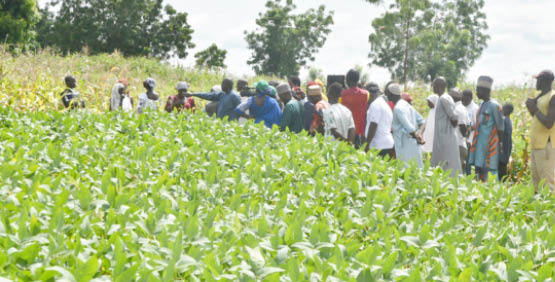How Gombe rural communities record increased crop production
Malam Yahaya Amuga is a subsistence farmer in Amtawalen, a rural community in Billiri Local Government Area of Gombe State. He farms on his inherited farmland, located on the outskirt of their village. In the past, when the land was very fertile and fertilizer was accessible, Malam Amuga used to harvest about 10 to 12 […]

A woman farmer explaining some points in her farm in Gombe
Malam Yahaya Amuga is a subsistence farmer in Amtawalen, a rural community in Billiri Local Government Area of Gombe State.
He farms on his inherited farmland, located on the outskirt of their village. In the past, when the land was very fertile and fertilizer was accessible, Malam Amuga used to harvest about 10 to 12 bags of maize from his small farm.
Apo-Dutse: Inside Abuja’s unmotorable slum
Kano farmers groan as dam water washes away farmlands
After several years of harvesting, the same plot of land and the skyrocketing price of fertilizer, the farm now hardy provides enough yields to Amuga to even feed his family before the next rainy season.
However, in the past two years, the subsistence farmer witnessed a lot of improvements in terms of productivity and the good yields from his aged farm, courtesy of new techniques of farming.
Through intervention project, Mr Amuga and other farmers said they were producing 10-15 bags in the past, but now producing over 20-30 bags after harvest from the same farmlands they had farmed on over the years.
The project, which seek to support rural farmers with new farming techniques to improve yields, is being implemented by Sasakawa Africa Association (SAA) in partnership with the Gombe State Agricultural Development Programme (GSADP), in Billiri, Kaltungo, Shongom and Yamaltu/Deba LGAs of the state.
During a field trip undertook by Sasakawa to some of the communities to assess the impact of the project, some of the beneficiaries shared their experiences.
According to Mrs. Aisha Abba, prior to the coming of SAA to their community, her yield was only seven to eight bags, “but now it has increased to over 15 bags.”
On her part, Mrs. Abigail Eli, leader of Shidiyen-nan Women Farmers Group in Lareka Community, said the training they received from SAA has empowered women in her community, especially in the area of processing and marketing of their agricultural produce.
She said SAA and the GSADP have enhanced the income of women farmers in her community through value chains addition.
“We can now process the soya beans we produced to soya milk suya, beans cake, make salad from moringa leaf among other things,” she said.
Mrs. Eli noted that the intervention had given dignity to women in her community as they now have income of their own to meet their needs and those of their children.
Mr. Ayuba Hamma from Sainsai Cooperative Group, said through the SAA’s training and technical support, they have now realized that using old or traditional means of farming would only impoverish them and cause wastage of resources.
“SAA exposed us to improved seedlings as well as extension service on farm management, timing with regards to planting, crops spacing as well as fertiliser application, adding that those techniques were game changers for them,” he said.
In Shongom LGA, women groups that benefitted from the SAA interventions, said it helped them to improve their nutritional status through training on how to use the local food produced within their communities.
Leader of Kwada Multipurpose Society in Lalaipido village, Mrs. Elizabeth Danlami, said the crops cultivated through the intervention of the association, had improved their nutritional status in the community.
“SAA has given us training on how to process the food we cultivate in various forms in order to balance our diet and our children are no longer malnourished.
“As you can see, we have displayed some of the foods we made locally with high nutritional value which we use for our consumption as well as business purpose.
Mrs. Ruth Bitrus, Leader of Mirmu Women Multipurpose Society in Diga Community of Shongom LGA, said the Sassakawa empowered women, especially in the areas of processing and marketing of agricultural produce.
Speaking to newsmen at the end of the tour, the Acting Country Director of SAA, Dr Abdulhamid Gambo, said they were in the communities to interact with the beneficiaries, and to assess the progress so far made as well as challenges and how to improve on them.
Dr Gambo said; “Initially the focus was how to support farmers improve on productivity, but we later came to support farmers along the value chain intervention, production, processing and to the market.”
The country director revealed that they have 148 Community Demonstration Plots (CDP) in nine out of 11 LGAs of the state, where they showcase to farmers proving technologies for improved crop production.
